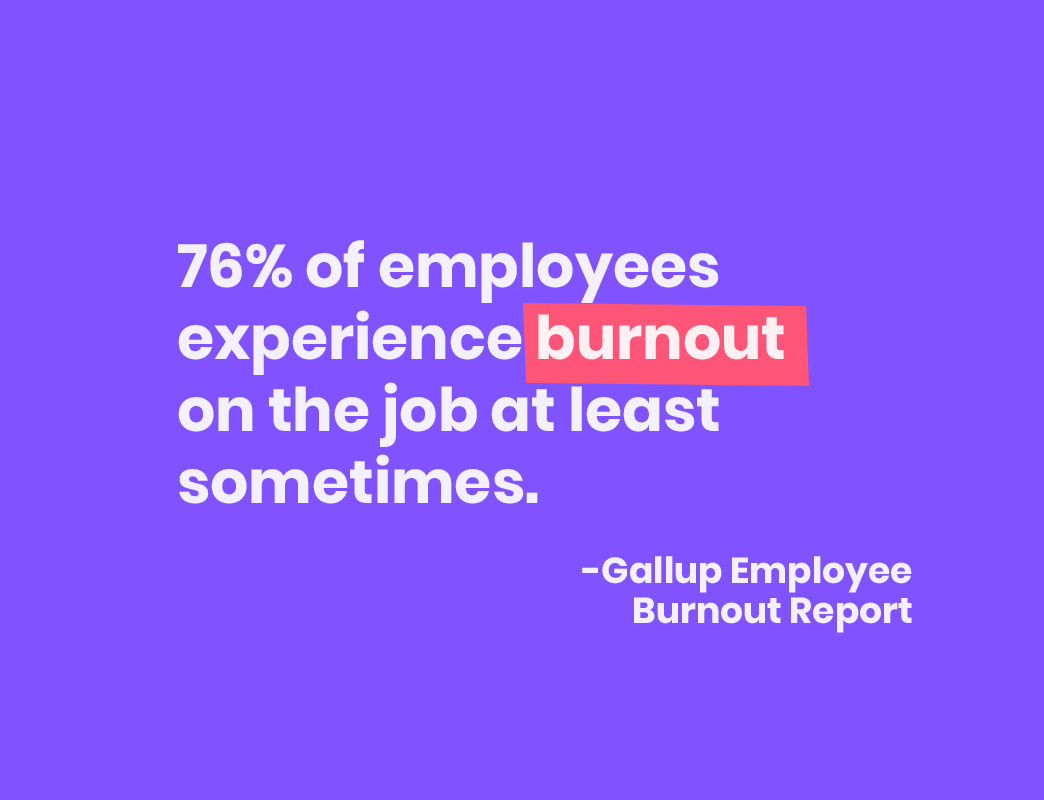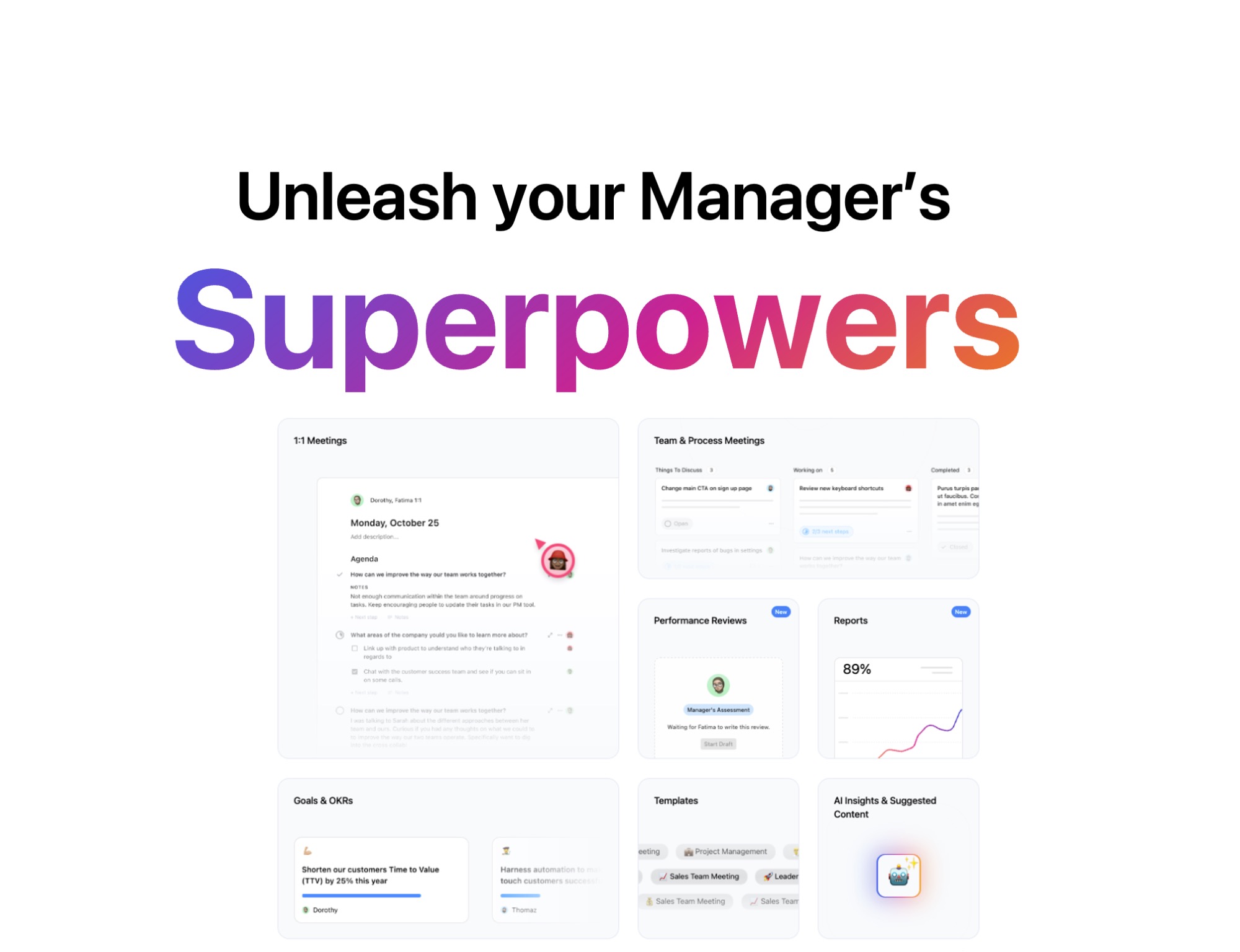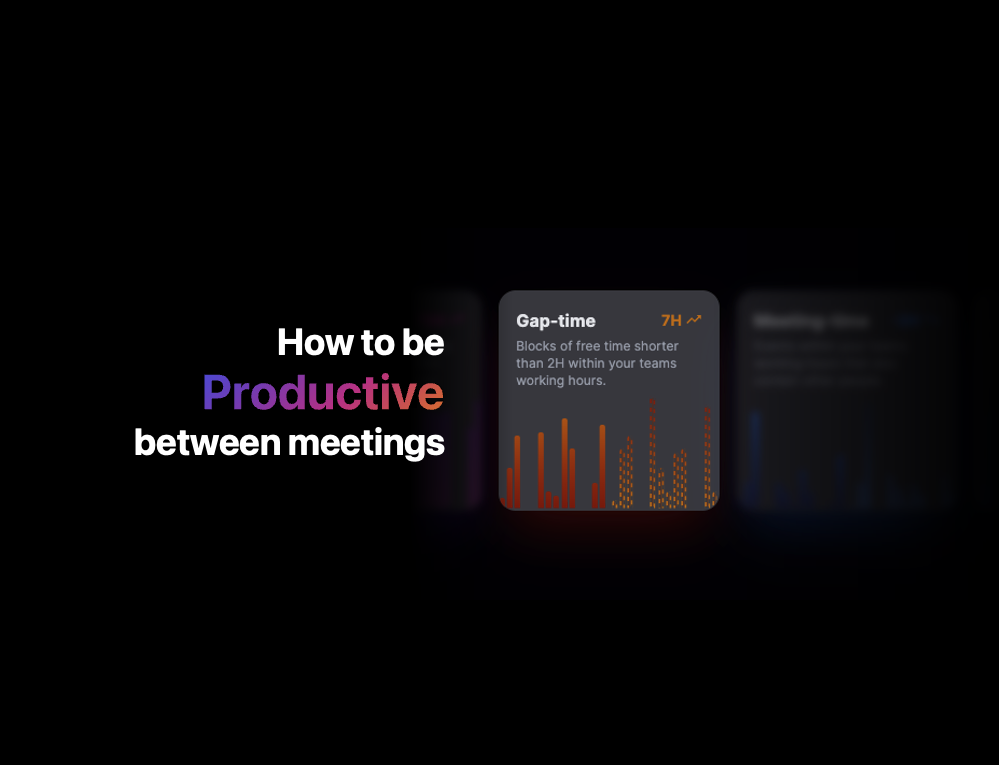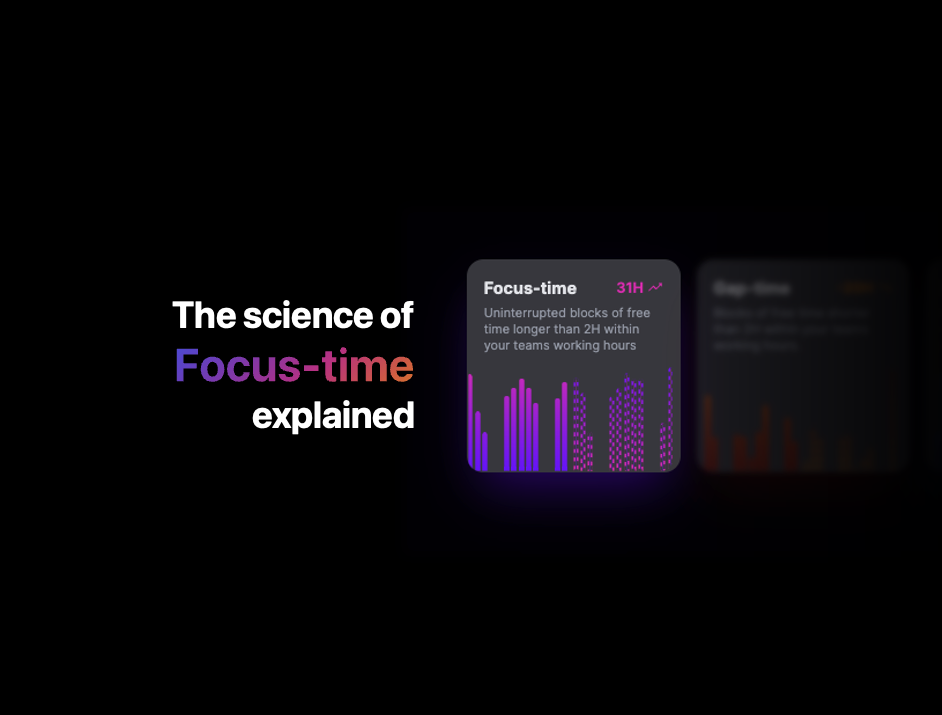Employee burnout: How to spot and prevent it
11 min readThe majority of employees will experience burnout at some point in their careers. Learn how to spot burnout, help employees going through it, and ways to prevent burnout altogether.

In today’s work atmosphere, we wear busy like a badge of honor.
Tech companies are known for their fast-paced environments and culture of overwork. And while it takes incredible brain power and tons of sleepless nights to start a company, it’s important to watch out for the potential dangers that come with working too hard and too fast.
One of the most prominent pitfalls any company faces is employee burnout.
About 76% of the workforce experiences employee burnout on the job at least sometimes, and 28% of workers say they’re burned out “very often” or “always” at work.

The majority of your employees will experience burnout at some point in their careers. And now more than ever, burnout looms as tons of workers feel overworked and overwhelmed from the fast shift to remote work.
Since the start of the pandemic, nearly 42% of people across the globe reported a decline in their mental health.
So how can you keep your eyes peeled for burnout as you lead through a crisis? And, what steps can you take to help your employees recoup, while also preventing future brain drain?
Today, we’re talking through:
- Why burnout happens at work
- How to spot employee burnout
- The impacts of burnout on your business
- How to stop burnout in its tracks
Why burnout happens to the best of us
The myth of burnout is that you work too much and burnout follows. Employees who fall into this camp are known as engaged-exhausted. Emma Seppälä and Julia Moeller told us in Harvard Business Review that one in five employees is highly engaged at work (read: invested and productive) but also reports high symptoms of burnout. This engaged-exhausted state is certainly one to watch for on your team, but burnout isn’t monolithic.
Employee burnout happens when employees’ basic needs aren’t being met. No matter what those needs might be.
It can creep in when your employees don’t feel connected to your company’s purpose or when your team isn’t aware of their goals and metrics. Or, even when your employees feel disconnected from their coworkers. (Cue the importance of intentional meetups with your remote team right now.)
The root causes of burnout stem from the workplace, not the individual
When burnout hits, companies default to giving the problem-solving burden back to their people. It’s the employee who needs to take a vacation or regulate her emotions. Remedies like meditation and yoga have been touted for years to help people manage stress.
But offering up these personal solutions doesn’t eradicate the problems your employees face at work. They offer an avenue to tone down symptoms, not address the root issue and avoid burnout altogether.
“Although developing emotional intelligence skills — like optimism, gratitude, and hope — can give people the rocket fuel they need to be successful, if an employee is dealing with burnout, we have to stop and ask ourselves why. We should never suggest that if they’d just practiced more grit or joined another yoga class or taken a mindfulness course, their burnout would have been avoided.”
–Jennifer Moss for HBR
How to spot employee burnout: Look for these 4 symptoms
The World Health Organization classifies burnout as an occupational phenomenon that contributes to larger health problems nationwide. Along with the classification, they offered up warning signs to watch for, so you can spot burnout among your employees.
The symptoms to watch for:
- Fatigue
- Negativity toward work
- Disconnection from projects and teammates
- Reduced professional efficacy
When these symptoms appear, and persist, burnout is present for your team. With all that exhaustion and negativity bottled up, sick days, health issues and disdain for work can easily follow.
Pro tip: Catch employee burnout before your team members reach their breaking point. If one of the above symptoms pops up, get involved. Ask your employee what’s bugging them at work. Ask how they’re feeling. Encourage rest and breaks. Try to address the root issue before other symptoms follow suit.
The impacts of burnout on your people and your business
Collectively, companies waste $530 billion on lost productivity from unwell employees every year. Burnt-out employees disengage with their roles and productivity suffers. Even your highly-engaged, rock star employees struggle to maintain productivity once burnout hits.
On top of higher operational costs and lower productivity, employees who frequently experience burnout are:
- 63% more likely to take a sick day
- 23% more likely to visit the emergency room
- 2.6x more likely to actively seek a new role
According to research out of Stanford, workplace stress also comes with a costly healthcare price tag. It equates to nearly $190 billion in healthcare spending in the U.S. alone.
These healthcare costs impact your business, too. Just think of the insurance premiums for all those ER visits, on top of the employer costs, which are already on the rise. And, think of the financial toll (and stress) those related health problems bring for your employees.
Once employee burnout sinks in, the ripple effects can suck your employees into a whirlpool of connected problems that feel impossible to pull yourself out of.
Unhappy and unhealthy employees impact:
- Absenteeism
- Performance
- Customer ratings
- Quality
- Profit
Spending too much of your paycheck on health issues causes financial strain, making employees stress over their compensation. It’s easy to suddenly think your employer can’t meet your climbing financial needs, furthering burnout. And it becomes commonplace to miss work when your health is on the line. This burnout continuum is hard to escape, and eventually, it pushes exhausted team members to seek out new roles.
Summed up, burnout skyrockets stress-related health expenses, tanks your customer outcomes and perpetuates organizational turnover.
How to help an employee with burnout
Now, for the good part. As a leader at your company, you can help fix burnout for employees who are suffering. And, you can prevent it for the rest of your workforce, too.
Taking a sick day or a vacation won’t solve for employee burnout. You have to take strides to better manage your team and thwart burnout before it happens. Here’s how.
1. Model healthy behavior
It’s an old trope, but actions really do speak louder than words.
Don’t just say you support mental health. Model healthy behavior for your team, so your employees feel they can prioritize self-care and set boundaries, too.
Safely take time off and maybe even enjoy a staycation. Especially now, it’s important to limit how much we’re giving to our jobs. With mental health declining and signs of burnout rising since the start of the pandemic, now isn’t the time to bank your PTO or work until dark.
As a manager, your remote team needs more support and care right now than you might be used to. In fact, more than half of professionals say their burnout has increased since working from home. Show your employees it’s okay to say no and it’s okay to sign off in the evening (even if we have nothing better to do).
“It’s difficult to set these boundaries while we all are locked at homes and work is one of the very few activities we can do. But I don’t encourage overworking. I believe we still need to have a full weekend to replenish our energy resources and get ready for a new week.”
-Jonas Olausson, Founder of Joinative
And if thinking of logging off for the night stresses you out entirely, find a schedule that suits you. Then, keep your team in-the-know. It might mean signing off at 5 p.m. and setting a 2-hour window where you completely disconnect. Or, it might mean getting up early to tackle some projects in silence, then checking out for a long lunch break.
2. Encourage employees not to clock more than 50 hours per week
Gallup’s analysis shows that the number of hours people work each week is connected to burnout. In fact, the risk of employee burnout significantly increases when employees work more than 50 hours per week. And it climbs even higher when employees clock more than 60 hours per week.
Some company cultures praise overwork. The more time you log, and the more evenings you lose, the more dedicated you are. But this throws work-life balance completely out of whack. And it isn’t sustainable or healthy (for anyone).
Taking meaningful breaks is important. A recent survey found that 89% of professionals are more productive after exercising and 96% report feeling less stressed after working out. Giving your team the time to employ healthy habits is beneficial for everyone. If you want to go a step beyond making sure your employees have time to practice healthy habits, try promoting them by giving your team access to fitness classes through a benefits program such as ClassPass. Or, if you’re on a tight budget, try a simple and fun activity challenge. This can help employees prioritize their physical health and take breaks that will actually leave them feeling refreshed.
Check-in on your team and make sure they’re not working too much. Encourage breaks and prioritize outcomes over outputs, performance over presence. And, if you’re online weeding through your inbox at 7:30 p.m. (after your 2-hour break, of course), let your team know you won’t bug them about any issues until the next day.
3. Be flexible with work schedules when possible
Build flexibility into employee schedules. At Sharpen, our SVP of Marketing makes a habit of saying “We can be endlessly flexible as long as the work gets done.” And it’s really been a huge relief for our team. Especially during our time working from home.
Some of my coworkers are parents helping with homeschooling, some have doctor’s appointments to go to, and we all have the occasional internet issue. It can be tough to accomplish everything, for work AND life simultaneously, in the typical confines of a 9-5 schedule.
As long as your team produces, allow them to prioritize their work and balance the other demands of life. Give employees the option to log hours a little bit earlier or later than usual so they can build a schedule that fits them. Too often, we forfeit balance for the appearance of output.
4. Set clear expectations
A lack of communication, transparency and purpose crushes organizational trust. Employees who aren’t connected to a common cause disengage at work, then burn out. According to customer service and employee empowerment expert Jeff Toister, it’s called learned helplessness.
To avoid this kind of disengagement, set clear guidelines, and communicate frequently about expectations. Have team meetings to review goals, talk about progress and troubleshoot important issues. Hold one-on-ones to give your employees individual attention, so they can ask clarifying questions about performance or expectations. Leave your door open and talk often, so you can keep your team engaged and informed.
5. Give employees visibility into their metrics and goals
Only 20% of employees say they’ve had a conversation with their manager in the past 6 months about how to reach their goals.
When employees don’t understand how their daily work feeds into business and personal goals, they disengage with their work and burnout follows shortly after. Make your team goals (and company) goals visible and accessible, so employees always know what they’re working toward.
And, give employees updates on their progress toward those goals. What KPIs do they need to meet this month? How about this quarter? Once you nail down the metrics you’re tracking as a team, surface daily progress to your team. Did your CSM team get a customer survey response after their implementation today? Or, did your marketing team reach their SQL goal? Share progress daily to motivate employees, so they understand their role in company success.



